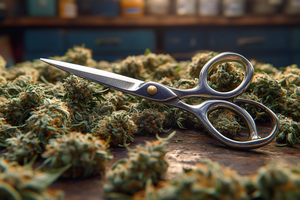
What Is Plant Training?
“Plant training” involves physically manipulating the cannabis plant to promote the growth of more bud sites, thereby increasing indoor yields.
Why not let the plants grow naturally? Cannabis typically grows in a “Christmas Tree” shape optimized for sunlight rather than grow lights. Unlike the sun, which rises and sets, providing light from various angles, indoor grow lights shine from a fixed position above the plants.
Additionally, indoor grow lights have limited penetration compared to the sun; for instance, the light from a 600W LED Grow Light is effective for only a few feet, while sunlight remains usable for plants even after traveling 93 million miles.
Even outdoors, lower buds tend to be smaller than the top ones because cannabis is a wind-pollinated plant that favors higher buds.
This difference becomes more pronounced indoors. With indoor grow lights, most light is directed straight down onto the top of the plant, leaving the sides with insufficient light. As a result, the Christmas Tree shape can be inefficient indoors, leading to one large top bud and many smaller, lighter ones.
The main goal of plant training is to create multiple top colas to maximize the efficiency of indoor grow lights. This ensures that less light is wasted and overall yields are higher.
Three Main Types Of Marijuana Plant Training
-
Bending and securing parts of the plant while causing little-to-no physical damage to the plant
-
Damaging or removing parts of the plant in a strategic way to get it to grow in a more desirable shape
-
Manipulating timelines to get faster or bigger yields
Usually, growers employ multiple types of plant training techniques because they complement each other. However, it's also possible to use just one method.
For instance, when growing auto-flowering strains, you can't manipulate the timelines, and it's generally advised not to damage the plant due to their short lifecycle, as this could result in stunted growth. Therefore, for auto-flowering plants, the primary technique is bending and securing the branches without causing harm.
Bending & Securing Parts of the Plant
Bending and securing parts of your plant is usually referred to as “Low Stress Training” (LST).
General Low Stress Training (LST) – LST is the process of bending stems and securing them in place. The general idea is to bend tall stems down and away from the middle of the plant as it grows so the plant takes on a more flat and wide shape. This should be started when the plant is still a seedling since its young stems will be flexible, while the stems of older plants become rigid and woody. Some growers use the term “LST” as an umbrella term to cover all types of plant training, while others use it to refer only to bending.
Damaging or Removing Parts of the Plant
These training techniques all involve pruning the plant in some way to improve growth and increase yields indoors.
Topping & FIMing are ways of damaging the plant at a very young age to lead to plants growing more bud sites.
In the next picture, you'll notice how the plant "splits" near its base. This split indicates where the plant was topped or FIMed, which broke the apical dominance. As a result, the plant redirected its energy to develop multiple stems into main colas, rather than concentrating on producing large buds on a single main stem.

Manipulate Timelines
These aren’t necessarily “training” techniques per se, but they are techniques that growers use to increase yields for free, and the main principle is the same – more buds directly under the grow light!
12-12 From Seed is the technique of trying to make seedlings start flowering (making buds) as soon as possible by giving them a “12-12” light schedule from seed. The idea is to get a harvest as quick as possible.
Sea of Green (SOG) is a technique related to "12-12 From Seed." The idea behind SOG is to grow many small plants instead of a few large ones. This method allows growers to create a sea of buds without needing to perform any plant training, resulting in significant yields in less time.
The key strategy is to let seedlings grow for only 4-5 weeks before switching them to the flowering stage. Since each plant doesn’t need to become very large, the time required before flowering is significantly reduced. Many growers also “top” their seedlings by removing the tips once the seedlings have about 4-6 pairs of leaves.

As a grower, you can significantly influence the final size and shape of your cannabis plant by employing proper training and growing techniques while the plant is still young.
These techniques include topping, FIMing, low-stress training (LST), main-lining, supercropping, defoliation, Sea of Green (SoG), Screen of Green (ScrOG), and more. This page provides detailed explanations of these methods and other strategies to help you shape your cannabis plant to your desired size and maximize your yields, whether you aim for small or large plants.

However, no matter how well you train your plants during the vegetative stage, some growth patterns (and many of aspects of your buds like appearance, smell and potency) are going to be determined by your plant’s genes, especially in the flowering stage. If you don’t have access to cannabis seeds or clones where you live, you can control the genetics by growing a strain from a trustworthy breeder and ordering seeds online.

